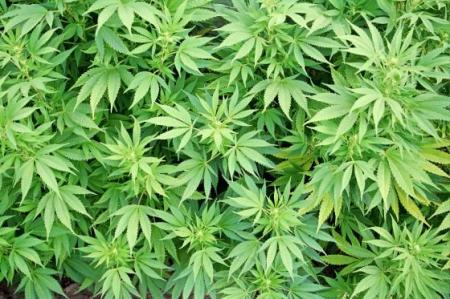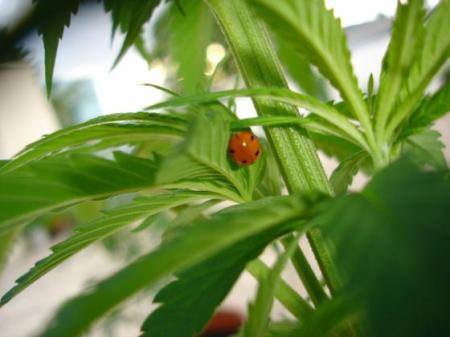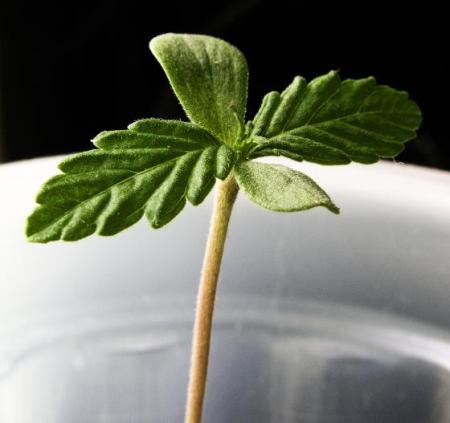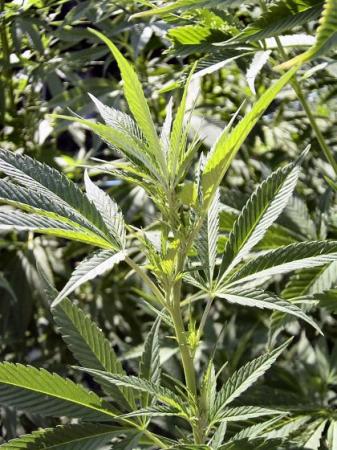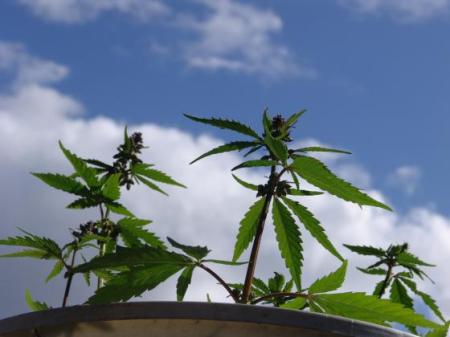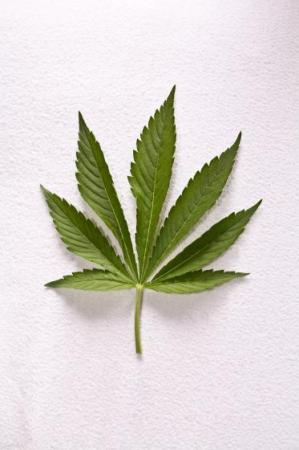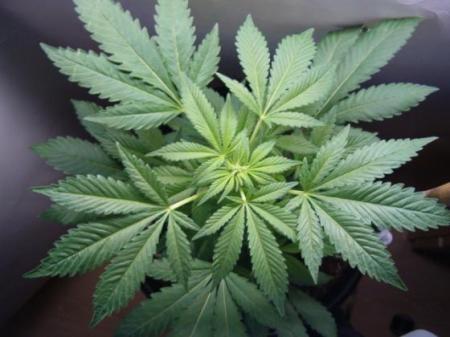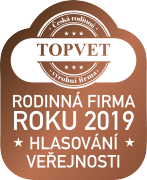Cannabis sativa L.
Cannabis Sativa L.
Family: Hemp family (Cannabaceae)
Vernacular and other names
Marijuana, weed, fountain of happiness, laughing tobacco, hashish, hemp
History
The first mention of cannabis dates back to seven thousand years ago in Babylonia. 6,000-year-old remains of hemp fiber have been discovered in China. The first written references to the therapeutic use of cannabis date back to 2737 – 2697 BC. The then emperor Shen-nung was a renowned healer and probably the author of the oldest Chinese herbarium. He used cannabis to treat malaria, rheumatism and pain relief. Hemp wine was recommended as an anesthetic during operations. In India, cannabis was used to improve mood and aid digestion. Cannabis soon spread from Asia to Africa. The Hottentots, Bushmen and Khosa of Africa have used cannabis for centuries to treat malaria, dysentery, dysentery and fever. In Europe, cannabis has been used for centuries to treat asthma, cough, epilepsy, pain, sleep disorders and, of course, skin problems. During the reign of Queen Elizabeth, farmers who did not grow hemp in their fields were fined. Napoleon's campaign into Russia was motivated by an attempt to obtain Russia's hemp wealth. Cannabis tinctures and extracts were formerly used for anesthesia and to induce restful sleep. Cannabis was used in both human and veterinary practice. Columbus spread it across the Atlantic. In the 20th century, cannabis was somewhat demonized, but today it is the subject of extensive scientific research around the world. In many states, cannabis is already legal for the treatment of various ailments. Hemp is of course usable as a technical plant in the production of paper, fabric, canvas, carpets, nets and ropes. Nowadays, the cultivation of hemp as biomass is becoming more and more widespread.
Occurrence
It is a traditionally cultivated plant spread practically all over the world. Cannabis thrives better in warmer areas and on clay soils. The origin of hemp is the region of Central Asia and India. It spread to Europe around 500 AD. However, there are also findings that support the assumption that cannabis was already in Europe 3000-10000 years before Christ. Cannabis seed is the most widespread type of cannabis. The second type is Indian hemp - Cannabis Indica Lam.
Description
Hemp is an annual herb, 80-350 cm tall, with a straight stem with short branches in the upper part. The palmate leaves are 5-7 numerous, the leaflets are lanceolate and coarsely toothed. Female plants are larger than male plants and are more leafy and darker. Male inflorescences are paniculate and female inflorescences. Male flowers are yellow, while female flowers are dark green. Male plants mature 4-6 weeks earlier than female plants. Under normal conditions, 53% of the plants are male and 47% are female. The fruit is a gray-brown achene covered with a bract. The seeds have a yellow-brown to brown color and a waxy surface.
Used parts
In medicine, mainly the leaf and flower are used. Hemp oil obtained from hemp seeds is most often used in cosmetics.
Active substances
Hemp contains a wide range of substances (organic acids, carbohydrates, phytosteroids, terpenes and others). Hemp contains about 60 substances that are generally called cannabinols (cannabinol, cannabidiol, tetrahydrocannabiol, quebrachitol, p-cymol, humulene, cannabol and others). Hemp seeds contain up to 35% fatty oil. Cold-pressed hemp oil is rich in essential fatty acids omega-3 and omega-6 (contains up to 80% unsaturated fatty acids). The oil mainly contains linoleic acid, alpha-linolenic acid and the rare GLA gamma-linolenic acid. The oil also contains cannabidiol - CBD, which treats inflammation, relieves pain and has an antimicrobial effect. Delta-9-tetrahydrocannabiol, or THC, is used as a popular "light" drug. The resin in dried leaves and female flowers contains the most THC. The normal THC content in hemp is 5-15%, with technical hemp the THC content is 0.2%. Cannabinolic acid is obtained from hemp extract, which has a significant antibacterial effect. Cannabis contains two alkaloids (trigonelline and nicotine).
Classification
Sedative, antiemetic, analgesic, antiphlogistic, antioxidant, immunostimulant, cosmetic
Proven effects
Thanks to the high content of unsaturated fatty acids, it strengthens the barrier function of the skin (strengthens the hydrolipidic coat). Hemp oil is directly involved in increasing the content of ceramides in the skin. If the skin contains a smaller amount of ceramides, it begins to dry out, become itchy, red and hypersensitive. Linoleic acid is directly involved in the formation of ceramides in the skin. It reduces the manifestations of various forms of eczema and other skin diseases. It keeps the skin supple, smooth, hydrated and flexible. Hair and nails are strong, flexible and shiny after using hemp oil. Cannabis has strong anti-inflammatory effects. Hemp is also a very strong antioxidant. It is used to reduce the signs of aging, but also in Alzheimer's disease, Parkinson's disease, myocardial infarction, Crohn's disease, rheumatoid arthritis.
Marijuana inhalation is recommended for the treatment of glaucoma. 10-20 mg of THC will reduce intraocular pressure by 25-30% (up to 50% is described). However, the effect lasts only 4-6 hours. It is interesting that regular users of cannabis have virtually no effect.
Marijuana is also recommended for loss of appetite and nausea (during chemotherapy, during AIDS). The stimulation of taste occurs at doses of 5-10 mg of THC (temporarily up to 20 mg per day). At a higher dosage, the opposite effect occurs. In a clinical study with cannabis, an 80% success rate in suppressing anorexia was confirmed. Significant suppression of vomiting and nausea is achieved at a concentration of 10 ng.ml of plasma.
Cannabis has also found its use in cancer therapy. On the one hand, indirect against loss of appetite and nausea. But the direct effectiveness, which has been confirmed by several clinical studies, is also significant.
The ability of cannabis to dampen spasms is also significant. It is used to suppress muscle spasms in multiple sclerosis or spinal cord damage. Effectiveness is provided by cannabidiol, which, unlike THC, does not have psychoactive effects. Cannabis is also used to reduce other symptoms of multiple sclerosis. The therapeutic effect of cannabis is described in Parkinson's disease. For multiple sclerosis patients, cannabis helps with muscle pain, spasms, tremors, depression, tingling, weight loss, fatigue, double vision, incontinence and more. However, a whole range of results results from the subjective assessment of patients.
Cannabis is recommended for pain relief in Crohn's disease. It has been clinically confirmed by the California Medical Society. Cannabis not only relieved pain, but also improved appetite, adjusted body weight and relieved vomiting, fatigue and depression.
Cannabis is used to relieve pain. It is especially effective for milder chronic pain. After inhaling marijuana, the pain threshold increases. In some countries, THC is available by prescription and increases the effectiveness of morphine by up to 500%. Cannabis is very effective for an attack-like headache (migraine).
Clinical studies differ on the possibility of using cannabis for asthma problems. One study talks about the bronchodilating effect of cannabis, and the other about the bronchoconstricting effect.
Usage
• Different forms of eczema
• Improves skin and hair quality
• Problem skin
• Glaucoma therapy
• For nausea and loss of appetite
• Tumor disease
• Sclerosis cerebrospinalis multiplex
• Crohn's disease
• Pain relief
• Inducing peaceful sleep and relaxation
• Migraines
• Rheumatism
Conditions for achieving maximum effect
• Due to the side effects of THC, dose carefully and use the lowest possible effective doses.
• Doses are fundamentally different for different indications.
• Starting doses of 2 x 2.5 mg to 2 x 5.0 mg per day are recommended. If necessary, the dose can be increased up to 5 x 10.0 mg per day, or even higher.
• THC must not be used in patients with serious mental illness, schizophrenia.
• THC interacts with some medications. Therefore, always consult the use of THC with your attending physician.
Side effects:
It probably has a negative effect on short-term memory. The drug is demonized for its hallucinogenic effect. THC causes an increase in heart rate and increases blood pressure. One marijuana cigarette contains as much tar as three tobacco cigarettes (some studies speak of a ratio of 1:9). There are hypotheses that speak of a higher probability of infertility in marijuana users.
Interesting points:
• Clinically, any neurotoxicity has been disproved in rats even when using extreme doses of cannabis. Interestingly, synthetic WIN55, 212-2 is about 10x more effective than natural cannabis.
• Dr. Marks wrote of cannabis: "Some drugs are not prohibited because they are dangerous, but they are dangerous because they are prohibited."
• No withdrawal symptoms occur after stopping the drug. Therefore, in the case of cannabis, we cannot talk about addiction in the true sense of the word. It is rather a psychological habit (taste), such as the desire for chocolate.
• So far, no fatal THC poisoning has been reported in humans. On the other hand, several cases of death have already been recorded in people with heart and blood vessel disease.
• Cannabis is a psychoactive plant. This group also includes tea, coffee, tobacco... There was a fairly intense campaign against cannabis in America in the 1930s. Exactly in the spirit of the rule that a lie repeated 100 times becomes the truth. Hemp hindered the paper giant Du Pont, who had a patent for the production of paper from wood. In addition, hemp will provide as much material in 14 weeks as wood in 30 years. However, hemp was a traditional plant among farmers and therefore it was not possible to create a monopoly on it. A smear campaign against cannabis began in the press. After a few years, cannabis was so "demonized" that it was banned. The campaign escalated in the 1960s, when cannabis was declared a worthless hallucinogen.
• Israeli scientists have currently demonstrated the ability of cannabis to treat cancer (30% of tested animals were completely cured).
• Levi Strauss made the first jeans from hemp.
• Cannabinoids kill gliomas – brain cells from which brain tumors develop. Other brain cells are protected by cannabinoids.
• No pesticides are used when growing hemp because it is not attacked by any insects. And it grows so fast that it suffocates any weed.
Recipes
Topvet offers a wide range of preparations with a high content of cold-pressed hemp oil and hemp extract.
Herbs with similar effects
It is very similar to jojoba, avocado and almond oil in its effects on the skin.
In addition to personal experiences, information from articles and publications was used in the article:
- Cannabis: perspektivní protinádorový lék, časopis medicína
- Joy J. E., Watson S.J.Jr., Benson J.A., eds.: Marijuana and medicine: assessing the science base. Washington, DC., National Press, 1999.
- West, D. P, Ph.D. 1998. Hemp and Marijuana: Myths & Realities. North American Industrial Hemp Council. Retrieved on 23 April 2007.
- Adams R., Hunt M., Clark J. H., J. Am. Chem. Soc. 62, 196, 735 (1940).
- Dr. Hanuš, Isolation and structure of brain constituent that binds cannabinoid receptor, 1996.
- Adams R., Pease D. C., Clark J. H., J. Am. Chem. Soc. 62, 2194 (1940).
- Wollner H. J., Matchett J. R., Levine J., Leewe J., J. Am. Chem soc. 64, 26 (1942).
- Todd A.R., Nature 146,829 (1940); C. C. 1941, II, 1994.
- Assorted authors. 200_. State noxious weed lists for 46 states. State agriculture or natural resource departments.
- Whitson, T.D. (ed.) et al. 1996. Weeds of the West. Western Society of Weed Science in cooperation with Cooperative Extension Services, University of Wyoming. Laramie, Wyoming.
- Southern Weed Science Society. 1998. Weeds of the United States and Canada. CD-ROM. Southern Weed Science Society. Champaign, Illinois.
- Rätsch Ch.: Enzyklopädie der psychoaktiven Pflanzen: Botanik, Ethnopharmakologie und Anwendung. AT Verlag, Aarau, Schweiz, 1998.
- Novak J, Zitterl-Eglseer K, Deans SG, Franz CM (2001). "Essential oils of different cultivars of Cannabis sativa L. and their antimicrobial activity". Flavour and Fragrance Journal 16 (4): 259–262.
- Mechoulam R. .et al.: Nonpsychotropic synthetic cannabinoids as therapeutic agents. Pharmacol. 46, 267, 1991.
- Kubát K., Hrouda L., Chrtek J. jun., Kaplan Z., Kirschner J., Štěpánek J. (2002):
Klíč ke květeně České republiky.
- Neurologie / 27. 8. 1999 / Strana 18 / Medicína 7 / VI
- Shafer Commission, 1970, National Commission on Cannabis and Drug Abuse
- Costa Rica Study, Greek Study, 1971.
- Report of the Expert Group on the Effects of Cannabis Use, 1982
- MUDr. Eva Havrdová - Roztroušená skleróza (1.-3. vydání, nakl. Triton)
- MUDr. Eva Havrdová - Je roztroušená skleróza váš problém?
- Dr. Alexander Burnfield - Můj život s "ereskou" (edice Roska)
- Remedia Compendium II. vydání (Panax)
- Turner C.E. et al.: Constituents of Cannabis sativa. J. Nat. Prod, 43,169,1980.
- Hepler, R.S., Frank I.R.: Marihuana smoking and intraocular pressure. JAMA 272,1392, 1971.
- Ford L.B. et al.: Cannabis positive skin tests and respiratory symptoms. Ann. Allergy Asthma Immunol. 85, 238, 2000.
- Fořtová M.: Cannabis sativa L. - možnosti terapeutického uplatnění. Diplomová práce, Univerzita Karlova Praha, Farmaceutická fakulta Hradec Králové, 2001.
Author: Dr. Jiří Pantůček and the Topvet collective
© Copyright (2010) MVDr. Jiří Pantůček - all rights reserved. No part of this document may be reproduced or transmitted in any form or by any means, electronic, including copying, recording, or by any information retrieval system, including websites, without written permission.
All information contained in the herbarium has not been evaluated by the control authorities for the control of dietary supplements. All information contained in this plant herbarium is for educational, informative and entertainment purposes. This information should not be used for diagnosis, indication or change of treatment prescribed by a doctor. The plants listed in the herbarium are not substitutes for medicines. In the case of any treatment, it is necessary to consult the use of dietary supplements with your attending physician.




